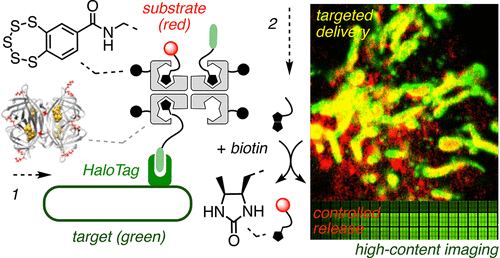- López-Andarias, J.; Saarbach, J.; Moreau, D.; Cheng, Y.; Derivery, E.; Laurent, Q.; González-Gaitán, M.; Winssinger, N.; Sakai, N.; Matile, S. “Cell-Penetrating Streptavidin: A General Tool for Bifunctional Delivery with Spatiotemporal Control, Mediated by Transport Systems such as Adaptive Benzopolysulfane Networks” J. Am. Chem. Soc. 2020, 142, 4784-4792

In this report, cell-penetrating streptavidin (CPS) is introduced to exploit the full power of streptavidin–biotin biotechnology in cellular uptake. For this purpose, transporters, here cyclic oligochalcogenides (COCs), are covalently attached to lysines of wild-type streptavidin. This leaves all four biotin binding sites free for at least bifunctional delivery. To maximize the standards of the quantitative evaluation of cytosolic delivery, the recent chloroalkane penetration assay (CAPA) is coupled with automated high content (HC) imaging, a technique that combines the advantages of fluorescence microscopy and flow cytometry. According to the resulting HC-CAPA, cytosolic delivery of CPS equipped with four benzopolysulfanes was the best among all tested CPSs, also better than the much smaller TAT peptide, the original cell-penetrating peptide from HIV. HaloTag-GFP fusion proteins expressed on mitochondria were successfully targeted using CPS carrying two different biotinylated ligands, HaloTag substrates or anti-GFP nanobodies, interfaced with peptide nucleic acids, flipper force probes, or fluorescent substrates. The delivered substrates could be released from CPS into the cytosol through desthiobiotin–biotin exchange. These results validate CPS as a general tool which enables unrestricted use of streptavidin–biotin biotechnology in cellular uptake.
DOI: 10.1021/jacs.9b13621
open archive unige:132259 • pdf ![]()
